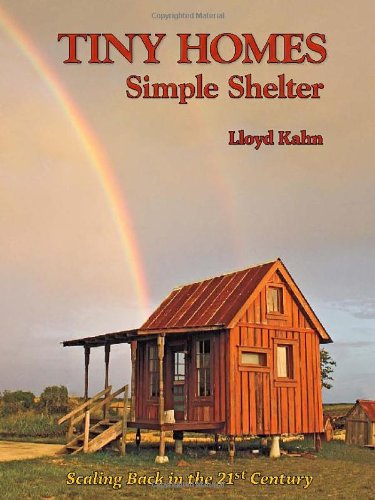In this book are some 150 builders who have taken things into their own hands, creating tiny homes (under 500 sq. ft.). Homes on land, homes on wheels, homes on the road, homes on water, even homes in the trees. There are also studios, saunas, garden sheds, and greenhouses.
There are 1,300 photos, showing a rich variety of small homemade shelters, and there are stories (and thoughts and inspirations) of the owner-builders who are on the forefront of this new trend in downsizing and self-sufficiency.
At the heart of our 1973 book Shelter were drawings of 5 small buildings, which we recommended as a starting point in providing one’s own home. Now, almost 40 years later, there’s a growing tiny house movement all over the world — which we’ve been tracking over the past two years.
Many people have decided to scale back, to get by with less stuff, to live in smaller homes. You can buy a ready-made tiny home, build your own, get a kit or pre-fab, or live in a bus, houseboat, or other movable shelter. Some cities have special ordinances for building “inlaw” or “granny flats” in the back yard. There are innovative solutions in cities, such as the “capsules” in Tokyo. There are numerous blogs and websites with news, photos, and/or plans for tiny homes, documented here.
If you’re thinking of scaling back, you’ll find plenty of inspiration here. Here’s a different approach, a 180º turn from increasing consumption. Here are builders, designers, architects (no less), dreamers, artists, road gypsies, and water dwellers who’ve achieved a measure of freedom and independence by taking shelter into their own hands.






The glowing reviews for this book can’t be real! I bought this book after reading the earlier reviews. As soon as I saw the low resolution quality of the cover photo, I thought, wait a minute, is this the right book? Then I started looking at the content, and I realized, gee, I’ve seen this content before. It’s pretty old. But almost none of the houses list a date or timeframe. The book mentions a few newer homes and builders, but by and large, I don’t feel that this book is really current. At the end, the author says that he wrote this book over the last two years, collecting images off the Web. Maybe that’s why there are so many tiny photos in this book, because that’s the best resolution he could get.I wondered why these reviews were so glowing, so I checked their authors. For most of the authors, this book is the only review. Many of the reviews have the same words, and they mention the publisher. How many consumer reviewers mention the book publisher? Come on, something’s fishy here.This book is a hodge podge of sheds, trailers, tree houses, mud houses, mini-vans, etc. Some of them look 10-20 years old, and most are kitschy. Some of the photos have nudity. If you are looking for a compendium of the latest trends in tiny houses, this book is not it. I have been studying and following small housing for several years, and this book was a disappointment.- – – – – – -ADDENDUM on Feb-9-2012I was kind of taken aback by some of the comments I received on my review, so I am adding this update.In the credits on the last page of the book, Lloyd Kahn wrote: “We combed over 5,000 photos to make our selection. Information came from hundred of blogs and websites. … With this kind of complexity, it was impossible to determine (or remember) credit for every bit of material, and we apologize to anyone not properly credited with helping us out. … About two years ago I started gathering information on tiny houses. A lot of it came from the web.”After one comment that I was too hard on Mr Kahn and possibly endangering his livelihood, I went to the library. I found 2 earlier books: “Shelter II” (1978) and “Home Work: Handbuilt Shelter” (2004). A small amount of content from 2004 is reused in Tiny Homes, and 20 pages of the new book are from pre-fab manufacturers (such as the cover photo). I guess Mr Kahn has been collecting photos of tiny houses, shacks and twig huts around the world for decades, and that is laudable. Clearly he is passionate about his subject. And if you enjoyed the 2004 book, you will enjoy Tiny Homes as well.But, I have been studying interior design for 4 years, and I was looking for something more formal and architectural, not so quirky. Also, after closely examining the book, the pages are already tearing out. I probably would not have posted my review in the first place if I hadn’t felt that the previous reviews (as well as WSJ and NYTimes) had mislead me. I of course don’t know if the Amazon reviews were planted, but after my additional research, I stand by what I wrote in my original review.
Packed Full of Fantastic Photo’s. Creativity Meets Functionality! After eagerly awaiting the arrival of this book, I was NOT disappointed! It is packed full of beautiful full-color photographs on every page. Quality of the book, text, photographic elements and diversity of tiny homes and simple shelters is superb!Various types of homes, different locations, building materials and styles mean this will appeal to a large variety of people. From city dwellers to cave (and even tree!) dweller, there is something here for nearly anyone. Whether you are just curious, desire a spare space for some peace and quiet or searching for a full-time alternative way of living…this book is sure to inspire a multitude of ideas.There is a nice selection of pre-fab/kits and other options as well as significant treatment of recycled materials. Examples of tiny homes range from ultra modern to quaint, primative to luxurious little escapes.Size, price estimates and materials are all mentioned. This is not a blueprint book nor a dedicated “how to” but rather a complete overview with a plethora of examples that will allow anyone to plan the perfect tiny home of their very own.Interviews with tiny home owners and designers are both informative and intersting. The writing style is engaging and the visuals beautifully executed.Well worth the wait!
Comments are disabled for this post.